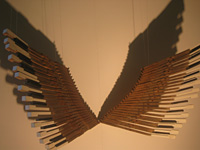|
||||||||||||||||||||||||||||||||
| Fine Arts | ||||||||||||||||||||||||||||||||

The discipline of Fine Arts is intended for students who wish to involve themselves as practitioners in the visual arts or related fields.
At UNSW, the study of this discipline is through the College of Fine Arts (COFA) at Paddington. Major areas of study within Fine Arts are: drawing, painting, printmaking, sculpture, installation and performance, photomedia, time-based art, ceramics, jewellery and textiles. Drawing is a common language, which supports many disciplines within the college, and forms the basis of a general visual awareness. Drawing is the source, and result of a passionate response to the world, the origin of radical thought given birth by finding equivalents in line and mark. Painting at COFA is interpreted broadly in terms of media and approach. Beneath these diverse outcomes however, lies a sound underpinning in both the handling of traditional and contemporary mediums and the intelligent application of theory and convention. Drawing, an overview of aesthetics, and the historical and contemporary positions of painting are compulsory and important parts of a Painting major. Printmaking focuses upon print media and is concerned with creativity through manipulation of the medium. Approaches which are examined in this area of study include digital imaging, etching, lithography, relief printing, screen-printing, photomechanical procedures, paper technology and various modes of delivery and presentation. The Sculpture, Performance and Installation area of study is a stimulating community of creative research and scholarship that aspires to excellence in the conception, production and presentation of contemporary art practices. Because contemporary Sculpture, Installation and Performance are often inter disciplinary and span a multitude of divergent practices, the program is inherently flexible, open to experimentation, and is tailored to accommodate each student's personal, creative direction. Photomedia is concerned with the issues of analogue and digital image production within the context of national and international contemporary visual arts practice and debate central to the development and production of artwork. Emphasis is placed on conceptual and practical investigations through specific projects designed to promote the acquisition of technical skills and foster critical individual interpretations in addition to conceptual and aesthetic development. Time Based Art is an interdisciplinary area embracing the development of experimental and critically conceived work in experimental film, video art, performance, experimental animation, screen based and interactive installation, interactive media and sound art. This study area is a leading area for the development of video art experimental film at a university level in Australia. Ceramics engages the theoretical and practical bodies of knowledge that inform ceramic practice. Studio projects provide for thorough investigation of processes, techniques and methodologies; and the exploration and translation of ideas through ceramic associated media. The ceramic studio encourages interdisciplinary approaches, exploration and experimentation within a context of research, critical analysis and reflection. Accordingly, the acquisition of skills is framed by theoretical and contextual studies that examine the historical, social and cultural settings of ceramics. Jewellery is concerned with the theory, process, and practice of contemporary jewellery design. The jewellery studio integrates critical and independent thinking with practical skills, processes and methodologies to produce a wide range of forms relating to the human body. Jewellery practice examines processes using metals, natural and non-metallic materials combined with relevant and new technologies. Technical knowledge is extended through experimentation and research to produce works that range from the personal and conceptual to the material and functional. These approaches within jewellery are complemented by the exploration and analysis of contextual studies in contemporary and historical jewellery practice. Textiles is a broadly-based, multi-disciplinary approach to making, learning and research into contemporary textiles. The emphasis is on textiles as an expressive medium in design and students are encourage to develop a strong conceptual and experimenatal basis for their work. Textiles introduces the cultural, historical and social content for textiles. The methodologies and structures of embroidery, weaving and the surface design techniques of dyed and printed textiles are introduced in technical and theoretical lectures, demonstrations and studio projects. Personal approaches to making including conceptual, formal, material and functional are explored in relation to traditional and contemporary practice or employment in design, art, craft and education industries.
Fine Arts can be studied as
|
||||||||||||||||||||||||||||||||



